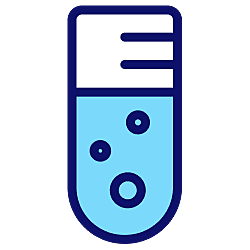At-Home Sperm Test
Test your fertility levels at home with a comprehensive, clinical grade sperm test by Mojo. Send a sample to our partner laboratory for fast, accurate results in 48 hours. Price includes couriering your sample to the lab, as well as advice and aftercare from a ZAVA doctor








-
Take a quick sperm test to find out about any fertility problems you might have. There’s no need to visit a clinic or a GP, and you can take the test from home or wherever you’re comfortable. All you need to do is:
- Order your test kit
- Organise your free courier to the lab
- Collect your sample
- Get results in 48 hours
Your sample will be analysed with an AI-powered microscope to provide a clear and detailed fertility report. This report will tell you about any possible fertility problems by detailing the health of your sperm and many other factors, including:
- Volume (the amount of semen you produce)
- Concentration (the number of sperm per millilitre of semen)
- Motility (how well your sperm moves)
- Quality (the number of abnormal forms)
IMPORTANT
- You will need to arrange a courier to deliver your sample to the lab. This is free and included in the cost of your treatment. We make it easy and provide full instructions on how to do this.




-
-
A sperm test kit is a test used to check the health of your sperm to help you with any fertility concerns you might have.
The test involves taking a sperm sample at home and sending it to our partner laboratory. After analysis, we can provide information on the amount of semen you produce, how well your sperm moves, the concentration of sperm, your total sperm number, and what they look like. This information can help you understand your fertility better and should be used as a screen to check for fertility issues.
-
-
The manufacturer of this sperm test (Mojo) reports that it is up to 97% accurate, and is a great screening tool to look for fertility problems.
To get the most accurate results, you must take your test correctly by following all of the instructions included with the test kit.
While the test kit we provide is up to 97% accurate, there are other home tests available on the market that are less accurate than this test and provide less information than the clinical grade laboratory test we offer.
You should always make sure you’re purchasing a test kit from a reliable source to avoid getting results that aren’t accurate.
-
-
This sperm test (by Mojo) will tell you:
- the volume of semen you produce
- the concentration of your sperm (the number of sperm per millilitre of semen)
- the motility of your sperm (how well your sperm moves)
- your total sperm number (how many sperm you produce every time you ejaculate)
- the quality of your sperm (how many abnormal sperm you have)
This information can give you a better idea of your fertility and your chances of conceiving. It can also give you a general understanding of your fertility if you want to start a family in the future.
You can message one of our doctors if you need help understanding your results or need further guidance.
-
-
You can do a home sperm test at any point if you want more information about your fertility. You might choose to take a sperm test if:
- you are planning to start or expand your family, so you can begin to improve your sperm health
- you are actively trying to conceive and want to understand if your sperm quality is causing an issue
- you want to check for any problems in the future
Records show that men’s fertility starts to decline around the ages of 40 to 45. So it’s important to be aware of your fertility if you want to have a child now or in the future.
-
-
You can take your sperm test at any time, as long as it's within 6 months of ordering your test kit. This is because you can only store the preserving liquid that comes with the test kit in the fridge for up to 6 months.
-
-
Take your sperm test by following the instructions you receive with it. You must follow these closely to make sure you get accurate results.
Step 1: Before your test kit arrives
- make sure you have not ejaculated for at least 2 to 5 days before collecting your sample.
Step 2: After receiving your test kit
- as soon as you get your test kit, put the preserving liquid in the fridge until you are ready to use it
- activate your test kit
- plan when you’re collecting your sample - you must collect it 60 minutes before your courier arrives
- book your free courier
- take the preserving liquid out of the fridge 45 minutes before collecting your sperm sample, to allow it to reach room temperature
Step 3: Collect your sample
- Wash your hands and genitals before using the kit.
- Do not use lubrication or saliva, as this could affect your results.
- Ejaculate into the sample cup - you do not need to fill the cup.
- Add the preserving liquid to your sample and swirl it gently before closing the cup.
- Place your sample into the thermal container and activate the heat pack.
- Place the heat pack on top of the sample cup and seal it inside the thermos.
- Package the sample up in the original shipping box and give it to the courier.
Get results
Once our partner laboratory has received your sample, you will be able to view your results in your ZAVA online account within 48 hours.
-
-
You will receive your results and a full report giving you information about your fertility.
This will detail:
- the volume of your semen. This is what carries your sperm to where it needs to go, which is needed for conception.
- the motility of your sperm. This will be a percentage number showing how well your sperm moves. The higher this number, the better the chances of your sperm reaching an egg.
- the concentration of your sperm. This is how much you are producing when you ejaculate.
- your total sperm number. The higher the number, the better your chances of conceiving. Your total sperm number can also give you information on your overall health, as a low sperm count may be due to a medical condition or can be improved with lifestyle changes.
Your sperm form (size and shape). You will be told how many normal and abnormal sperm forms you have, as this can tell you more about your chances of conceiving.
-
-
If your results show that you have any problems with your sperm, our doctors will be here to support you. They can:
- Provide clear advice on what to do next if you need more investigations
- Give you more information to support you with understanding your results (if you need help)
- Give clinical advice on improving your sperm health through lifestyle or dietary changes
- Provide treatment for certain conditions that can affect fertility, such as erectile dysfunction

Dr Babak Ashrafi Clinical Lead for Service Expansion
Accreditations: BSc, MBBS, MRCGP (2008)
Babak studied medicine at King’s College London and graduated in 2003, having also gained a bachelor’s degree in Physiology during his time there. He completed his general practice (GP) training in East London, where he worked for a number of years as a partner at a large inner-city GP practice. He completed the Royal College of GPs membership exam in 2007.
Meet our doctorsLast reviewed: 05 Aug 2022
-
Infertility, National Health Service [accessed July 2022]
-
Low sperm count, National Health Service [accessed July 2022]
-
What is infertility?, British Fertility Society [accessed July 2022]
-
Semen analysis, WebMD [accessed July 2022]








